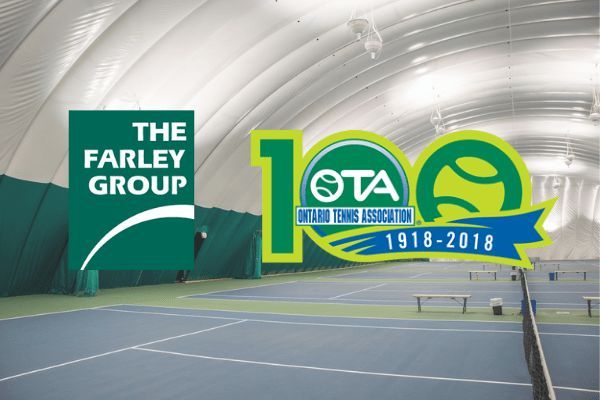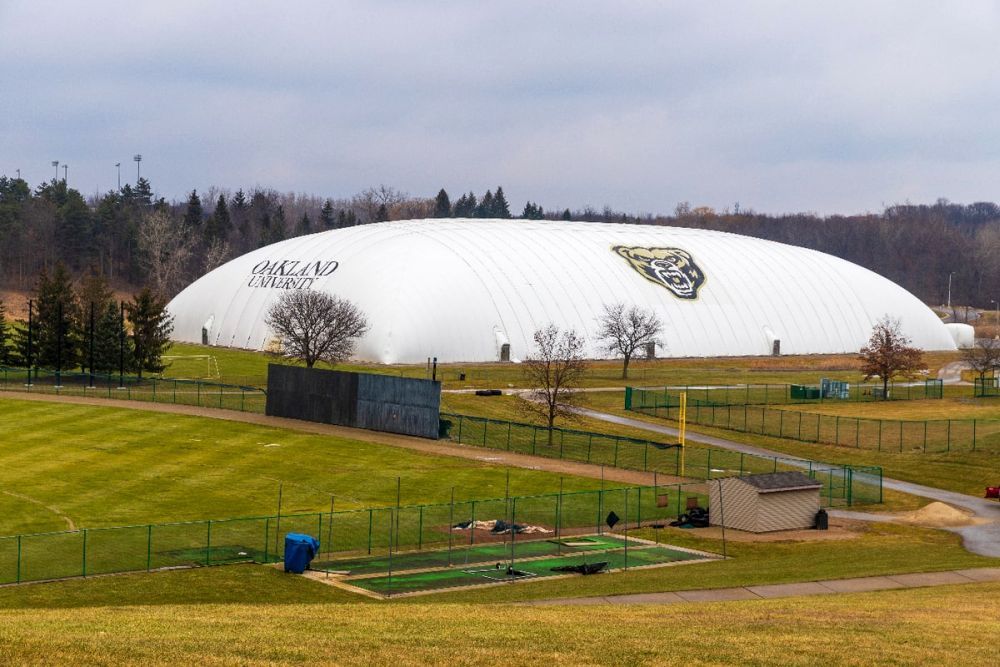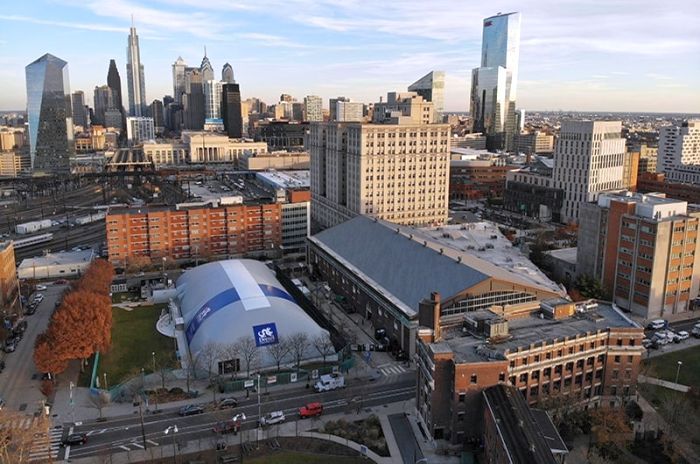
We collect basic website visitor information on this website and store it in cookies. We also utilize Google Analytics to track page view information to assist us in improving our website.

It goes without saying that 2020 has been a difficult year for sport clubs.
But today, we’re happy to share some news that’ll help us build a brighter future for the 250+ tennis clubs across Ontario.
As of October 1st, 2020, members of the Ontario Tennis Association now have access to a resource that could help them bounce back in 2021: a partnership with North America’s 1# Tennis Dome Supplier and Service Provider.
The Ontario Tennis Association (OTA) has announced that The Farley Group is the new Official Tennis Dome Supplier and Service Provider of the Ontario Tennis Association and its over 250 members. Effective October 1, 2020, the 4-year agreement is in place until September 30, 2024.
We can’t wait to lend our air structure expertise, as well as our passion for setting industry standards when it comes to service and support, to OTA members across the province! Here’s what this exciting partnership means for Ontario’s tennis clubs.
If you’ve ever taken or taught tennis lessons in Ontario, you’ve probably heard of the Ontario Tennis Association.
Founded in 1919, the Ontario Tennis Association (OTA) is the governing body for tennis in Ontario. The Ontario Tennis Association is the single largest provincial association within Tennis Canada, with 250 clubs and approximately 75,000 players across the province.
The OTA’s mission is twofold: to encourage participation in tennis as part of a healthy lifestyle, and to promote the pursuit of excellence in the sport for all tennis players.
With those goals in mind, it’s clear why the Ontario Tennis Association and The Farley Group are a perfect fit.
Here are a few important stats.
Today, tennis ranks as the 8th most played sport in the country, with about 6.6 million Canadians picking up a racquet in 2019.
But that number would be much higher if not for the startling lack of indoor tennis courts throughout much of the country.
Amazingly, a whopping 51% of Canadians say they would play more tennis if only they had access to convenient and affordable covered courts nearby!
Right now, only 10% of outdoor tennis courts get covered during the winter...and 85% of those covered courts are located in either Toronto, Montreal, or Vancouver! Millions of Canadians are being left out in the cold.
And this, right here, is where The Farley Group and the OTA can make a huge difference together. Canadians are clamouring for indoor tennis facilities, and tennis domes are the simplest, fastest, most cost-effective way to provide them.
We think tennis domes could be the key to getting more and more people involved in this incredible sport. Who knows ‒ with more tennis domes in Ontario, the number of Canadian players could climb to 7, 8, perhaps even 10 million people!
Truly, the sky's the limit.
Tennis domes (also known as ‘tennis bubbles’, which is the term used by Tennis Canada and others) are incredibly versatile structures that can be designed, constructed, and installed at a fraction of the cost of a brick-and-mortar structure.
Domes can be permanent or seasonal/temporary. You can have a year-round tennis bubble that offers air-conditioned play in the summer and warmth in the winter, or a seasonal dome that covers the court only from fall to spring.
Domes can be used to cover tennis courts, of course, but also soccer fields, pools, driving ranges, velodromes, volleyball courts...practically any sporting arena you could imagine.
We’ve also seen domes used as community spaces like gyms, party venues, and storage facilities! The possibilities are virtually endless.
Now, if you’re used to playing in the great outdoors, you might wonder what it’s like to play tennis in a dome. To be honest with you, it’s hardly any different from playing on a regular court.
Some athletes worry that a dome might feel “stuffy”, but that shouldn’t be the case. The Farley Group’s tennis domes are exceptionally well-ventilated (more on that later) and completely climate controlled for optimal, predictable comfort.
As for the playing experience? The only real difference is that domes will offer a cooler playing temperature during the warmer months than outdoor play, which means the ball will bounce slower than it might outdoors. But the change is so minimal that most players have no problem adjusting!
Here’s why now is the perfect time for this exciting new partnership.
It comes at a time when, in light of COVID-19, the advantages of a dome are more evident and important than ever before.
We know the risk of transmission is generally lower outside than indoors. That’s all well and good when it’s July, but as the temperature falls, so do the prospects of outdoor tennis.
The good news? The air inside of a dome is a lot closer to outdoor conditions than most buildings.
1. The Air Quality In a Dome Resembles Outdoor Conditions.
A typical dome contains 500,000 to 5,000,000 cubic feet of air; for a topical comparison, a typical classroom contains just 6,000 cubic feet of air.
2. Dome Ventilation Is Remarkably Better Than In Most Buildings.
Under ASHRAE standards, a normal classroom’s ventilation is designed to move 222 cubic feet of air per minute; domes have a minimum of 50 times more outside fresh air!
3. There’s Tons of Room To Breathe In a Dome.
At 6-foot social distance, a dome provides about 800 cubic feet of ventilation air per person per minute; a typical classroom with 20 students would provide 11 cubic feet.
In other words, you could say that playing tennis is a dome is the next best thing to playing outdoors!
The Farley Group is proud to be the Official Tennis Dome Supplier and Service Provider to Canada’s largest Provincial Tennis Association. Reach out to us to learn more about what we do or find out how your tennis club can benefit from this exciting partnership!
Have a dome emergency? Don’t wait. Call our 24-hour emergency service hotline at 1-888-445-3223 now!
Every air-supported dome The Farley Group builds is precisely designed and engineered to withstand the worst the local climate is expected to throw at it.
But let’s face it: without good maintenance, a truly wicked storm can topple even the toughest of domes to the ground.

And while many storm-damaged domes are quick to fix, the hit to your finances ‒ not to mention the community’s confidence ‒ might not recover so quickly.
As we approach the summer thunderstorm season, we wanted to share a few important tips and reminders to help you keep your dome (and its occupants) as safe as possible.
Read on to learn about the most common warm weather issues your dome will face, how to prepare your dome for a storm, what to do in an emergency, and why even the best dome operators can run into problems.
You wake up early on a muggy September morning to the sound of wind and rain pounding the window. Thunder growls in the distance, and your alarm clock is stuck, blinking, at 12:00 AM. You’re not normally at the dome for another few hours...but you’ve had three texts and five missed calls from your head of operations within the last ten minutes.
“Power’s out. Standby generator isn’t working. Checking owner’s manual...”
Uh oh.
You arrive on site just in time to see the dome ‒ half deflated, shuddering in the wind ‒ caught on a light pole near the perimeter. A tear erupts in the fabric membrane, and in seconds, the dome is flat on the ground.
What a nightmare!
There’s a reason why we’re telling you this horror story. It’s a perfect storm of the two most common culprits behind dome emergencies: nasty weather and mechanical failure.
With over 30 years’ experience servicing air structures, The Farley Group’s Dome Service Technicians have seen it play out almost exactly like this scenario more than a few times.
Here’s the thing...
While we can’t speak for other manufacturers, we can tell you that each Farley dome is custom-designed and engineered to conform to local building codes and climatic conditions. A licensed engineer inspects and stamps each dome to ensure it meets the location’s needs. Additionally, in especially windy areas, restraining cables will be included in the design to keep the dome secured.
What’s more, all our air structure packages are equipped with an emergency standby system that automatically activates during a power outage. Driven by a generator, this system keeps the dome inflated until power is restored.
However, like any large structure, a dome must be inspected and serviced on a regular basis if it’s going to perform to the high structural standards to which it was designed.
All the precautionary measures in the world won’t help if they’re not working as intended!
But here’s the good news: there are straightforward steps you can take right now to make sure your dome is storm ready. And you don’t have to wait until a storm’s on the horizon to do it.
First, be vigilant and check your local weather network regularly. Since you can’t watch the forecast 24/7, consider using an app that sends severe weather alert notifications to your phone.
Routine maintenance and inspections are more important now than ever, especially if you’re behind on things this year due to the lockdown. Now is the perfect time to review the 10-Point Dome Maintenance Checklist.
Above all, when a storm is on the way, take the necessary precautions to protect your dome from potentially costly damage.
If you have any questions about preparing your dome for a storm, you can always reach out to us at info@thefarleygroup.com. We’re here to help!
Unfortunately, it isn’t always possible to prepare yourself for extreme weather. Some events, like microbursts, can appear so suddenly and unexpectedly that you simply cannot see it coming.
When that happens, you need to act as quickly as possible.
If your dome is deflating, damaged, or at serious risk of damage, don’t hesitate for a minute. The longer you "wait and see", the greater the risk your air structure could suffer costly damage! Take these steps immediately to minimize the fallout and keep everyone as safe as possible.
Evacuate the dome immediately. Ensure there are no patrons or employees inside the dome or in the surrounding vicinity. If you need help, call 911.
Call our 24-hour dome emergency hotline (1-888-445-3223). You will speak directly with an experienced Dome Service Technician who will take your call immediately or return your call within minutes. Don't second-guess whether you really have a true emergency, just call!
Minimize the damage to your dome. The Dome Service Technician will help you determine whether to handle a problem yourself, schedule dome service soon, or dispatch an emergency service team to your dome ASAP. If you need emergency service, the technician will walk you through any interim solutions or stop-gap measures you can use temporarily while help is on the way.
You know the steps you need to take to keep your dome and its components in good working order. You know what to do if there’s a storm coming, and the immediate actions you must take to minimize damage and keep people safe if there is an emergency.
But there’s one problem...
If you were around when your dome was first installed, you probably remember feeling the excitement ‒ not to mention a certain amount of stress ‒ that comes with running a brand-new air structure.
Newly minted dome owners tend to be on high alert for anything and everything that could possibly go wrong. Some of the people we work with call for help more times than we can count over the course of that first year!
However, once you’ve learned the ropes, it’s easy to stop sweating the small stuff...and, occasionally, you may brush aside things that should be red flags. You might think, “Oh, that? It’s been like that for a while” or “We’ll wait and see if it keeps up.”
Now, we don’t mean to say that most dome operators are like this (and we know for a fact that you’re not!) But if you spend a long time meeting and talking to other dome owners, you’re bound to meet a few who are a bit ‘relaxed’ when it comes to maintenance.
Trouble is, there are many maintenance issues that simply should not be left well alone!
At The Farley Group, we encourage anyone who owns, operates, or manages a dome to have the entire structure inspected and serviced at least annually. Preventative maintenance will always save you bigger problems down the line!
The Farley Group can provide a detailed inspection of your dome, including climbing the roof of the structure. Our top priority (and yours), of course, is the dome’s structural integrity and the safety of the people inside.
With over 30 years’ experience servicing air structures, The Farley Group is the go-to service team for dome owners like you. Our professional service technicians have vast experience in all aspects of dome repairs and operations, from routine maintenance to full reconstruction.
Reach out to us online or call us at 1-888-445-3223 to schedule an inspection. Remember, we’re here to help. Stay safe!
Tennis Canada junior development program a smashing success
Vernon Tennis Association partnered with Predator Ridge for three-month program.
The first season of indoor junior tennis at the Predator Ridge Tennis and Pickleball Club was a real hit.
The Vernon Tennis Association (VTA) partnered with Predator Ridge to run a Tennis Canada developmental program that began in September and ran until Dec. 14. The program is for players aged six to 17.
“I am amazed how quickly the players develop with this program,” said coach Graham Cooper. “Many of these youngsters only started playing tennis this year.”
Athletic Bubbles Inflated to Improve Athletic Programming
If you’ve recently visited or even walked near Drexel University’s Vidas Athletic Complex or Buckley Recreational Field, then you’ve probably seen the “bubbles.”
These massive, stark white dome structures are now inflated over the tennis courts at the Vidas Athletic Complex and the turf field at Buckley Field — and they are pretty hard to miss. But why, exactly, are they there?


It’s what the Harvard Crimson are doing.
Same goes for the Princeton Tigers. Up north, the Seneca Sting are in on the action as well.
You might not have noticed, but more and more of North America’s best and brightest young athletes are practicing ‒ and even competing ‒ under air-supported sports domes.
And it’s not only collegiate teams who are embracing a new way to train. They’re following in the footsteps of professional superstars like the Toronto FC, who’ve been training under their own 88,000-square foot dome since 2011.
Want to know why? Let’s take a closer look at this trend.
Sports and domes are pretty ubiquitous. You’ve got the record-breaking Louisiana Superdome; Syracuse University’s massive Carrier Dome; and, of course, the venue formerly known as the SkyDome.
But here, we’re focusing squarely on a specific category of sports dome: the humble structures known as air-supported domes. Depending on where you’re from, you might know them better as sports bubbles.
Air domes aren’t made out of steel or concrete. They consist of a heavy-duty fabric membrane propped up entirely by air ‒ no posts or cross beams required. A 24/7 fresh-air ventilation system and specialized airlocks take care of maintaining the right air pressure.
You might not have had a chance to step inside a dome yet (which is an “amazing” and “awesome” first-time experience), but you’ve probably seen them from the outside. They’re hard not to miss when drive past! You can find giant, white air domes emblazoned with a colourful logo in campuses all across North America.
Some of these domes are inflated and used year-round, with air conditioning in the summer and heating in winter. Others are installed on a seasonal basis to bring an outdoor sport indoors for the frigid, cold months.
Of course, there’s no reason why a dome can only be used for sports! Many post-secondary institutions rent out their domes for all sorts of functions, from conventions to concerts.
But there’s a very good reason for their popular with sports...and that’s clear-span space.
Since air domes don’t use beams or columns, they can cover huge amounts of completely open space. There are no beams or columns to get in the way of the ball (or the participants!) which is crucial for any field sports like soccer or football.
Historically, very few post-secondary institutions could offer their athletes a full-size, indoor sports field of this calibre. That’s because the price tag on this kind of facility ‒ one that offers clear-span space in the tens of thousands of square feet ‒ would have been astronomical.
This is where air domes have really changed the game.
Colleges and universities can easily install a full-size sports dome at a fraction of the cost of a brick-and-mortar athletics facility.
The cost of a dome is well within the reach of practically any post-secondary institution that wants to build one, from big public colleges like Seneca to small, private institutions like Thiel College.
And don’t go thinking that sports domes are just the ‘budget’ option. We’ve also had the pleasure of installing domes at prestigious schools like Princeton and Harvard University. Whether you’re a state college or the Ivy League, domes just make good sense!
Admittedly, playing and practicing under the dome isn’t exactly like being outdoors.
A dome can easily cover a full-size football or soccer field, but there’s obviously a bit less room on the sidelines. Playing in a space that’s heated or air conditioned might take some getting used to. And, of course, you’ll miss the breeze in your hair and the sounds of a bustling campus around you.
However, it doesn’t take long for coaches and collegiate athletes to embrace the benefits of playing and practicing in a dome ‒ especially when they live in a colder climate.
Winter is a polarizing season. But whether you love it or hate it, you can’t argue with the toll it can take on your athletes.
Put simply, cold weather puts field sport athletes at a big disadvantage. It limits their ability to make gains in their training and improve their skills.
Besides, who really enjoys doing drills in the freezing cold?
Having your teams to practice outside in the winter puts them at considerable risk of injury.
Studies have linked colder temperatures to higher rates of injury in athletes. This is because the body’s natural shiver responses, combined with reduced circulation, ramps up the risk of muscle tearing or straining.
Not only that, but the transition from fall to winter means your field will be covered in frost, then snow. You’ll have players slipping, sliding and taking a spill on the wet grass ‒ which is all fun and games until somebody breaks a wrist or an ankle.
It just isn’t worth the risk.
Rain or snow, there’s still one place your athletes can go to train: the gym. By now, even if your campus hasn’t got a rec center, there’s a good chance someone has built one nearby.
No argument here. All athletes, from quarterbacks to gymnasts, can and should supplement their field practice with good old-fashioned conditioning.
But you and I both know that it cannot replace field time.
Running on a treadmill isn’t the same as running as a team on the grass. Indoor soccer drills, while useful, aren’t the same as practicing with teammates.
Any team that can continue their field training throughout the winter will always have an advantage against those who cannot.
Here’s the thing: sports domes aren’t meant to replace field time, either. Rather, a dome can actually extend your field time from 5 or 6 months to a full year!
In fact, many post-secondary institutions (like Princeton University) put up a dome over their field as soon as the football season ends. The team doesn’t miss a beat.
It’s not only sports teams and fans who are cheering for domes.
College and university administrations have also recognized how installing a dome can powerfully benefit campus culture, bring in new revenue, and help recruit student athletes and non-athletes alike.
We’ve created a guide that shows you how 3 top colleges are realizing these benefits right now. Click to find out how to get your free copy today!
